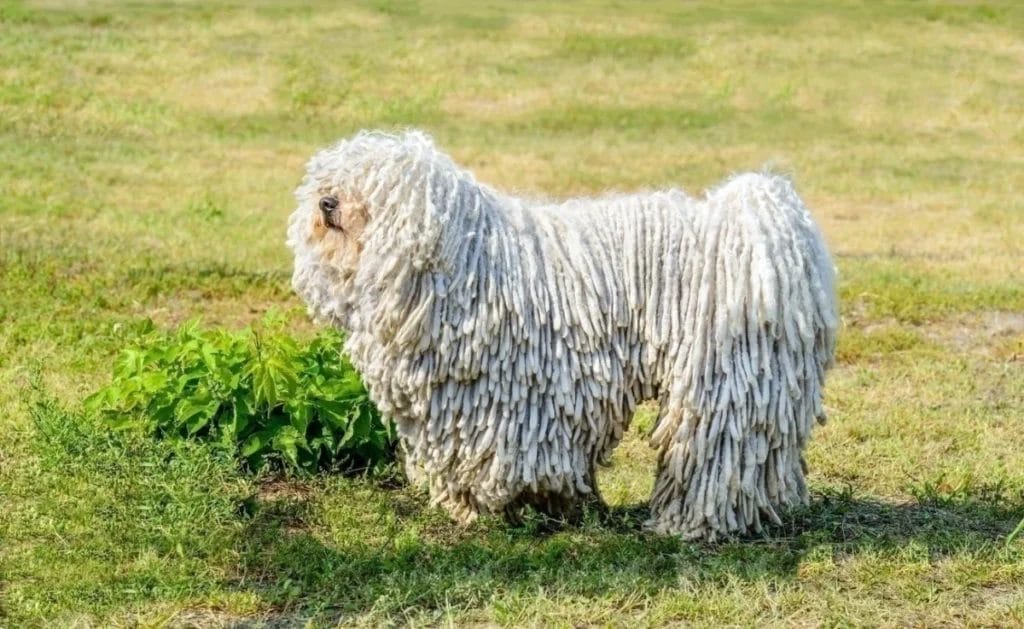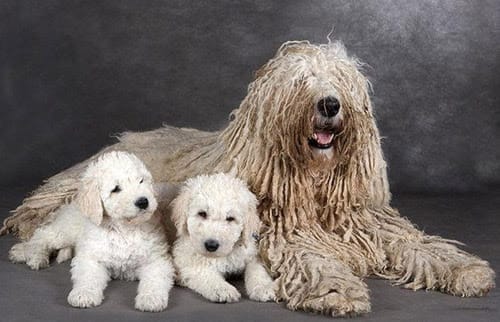The Komondor is an ancient dog breed thought to have arrived with the Magyar people to Hungary over a thousand years ago. They were developed to guard livestock and estates. Their striking coat provides camouflage and protection. The Continues to work as an excellent guard dog today.
Introduction Komondor Dog Breed
The Komondor is a powerful, independent livestock guardian that originated from Hungary over a millennium ago. They are a large, muscular dog covered in a floor-length corded coat that resembles twisted ropes or dreadlocks. This dense coat would conceal the dog amongst flocks of sheep and act as armor when defending against wolves or bears.
Komondors are calm and gentle with their owners, but wary and protective of their territory. They have a dignified and self-assured presence. Without plenty of exercise and mental stimulation, may become bored and destructive. An experienced owner is needed to provide firm leadership and training for this intelligent but stubborn breed.

Adaptability: ⭐⭐
Apartment Living: ⭐
Novice Owners: ⭐
Sensitivity: ⭐⭐⭐
Alone Time: ⭐⭐⭐
Cold Weather: ⭐⭐⭐⭐⭐
Hot Weather: ⭐⭐
All Around Friendliness: ⭐⭐
Family Affection: ⭐⭐⭐
Kid Friendly: ⭐⭐
Dog Friendly: ⭐⭐
Stranger Friendly: ⭐
Grooming Needs: ⭐
Shedding: ⭐
Drooling: ⭐⭐
Ease of Grooming: ⭐
General Health: ⭐⭐⭐
Weight Gain: ⭐⭐⭐
Size: ⭐⭐⭐⭐⭐
Trainability: ⭐⭐
Ease of Training: ⭐⭐
Intelligence: ⭐⭐⭐⭐
Mouthiness: ⭐⭐⭐
Prey Drive: ⭐⭐⭐⭐
Barking Tendency: ⭐⭐⭐
Wanderlust: ⭐⭐⭐
Exercise Needs: ⭐⭐⭐
Energy Level: ⭐⭐⭐
Intensity: ⭐⭐
Exercise Needs: ⭐⭐⭐
Potential for Playfulness: ⭐⭐
- Appearance: Large, muscular build. Coat consists of long, corded dreadlock-like fur. Typically white but can be cream or light brown.
- Characteristics: Steady, fearless, and protective. Serves as an excellent livestock guardian. Intelligent but also independent and stubborn.
- Popularity: Ranks 175th out of 197 breeds by the AKC. A rare breed, especially outside of Hungary.
- Lifespan: 10-12 years.
- Temperament: Calm and gentle with family. Wary of strangers. Courageous and protective. Dignified and confident.
- Coat Colors: White, cream, light brown/fawn. Puppies are born with smooth fur that eventually cords.
- Origins: Ancient Hungarian breed dating back over a thousand years. Developed to guard livestock against predators.
How to Care for a Komondor dog breed
Komondors require considerable grooming and plenty of exercise. Here are some tips for meeting their needs:
Food:
- High-quality commercial dog food formulated for large breeds. Avoid overfeeding.
- Meat should be the first ingredient and main protein source.
- Supplement with vitamins and joint supports.
Environment:
- Large, securely fenced yard for running and playing. These dogs need space.
- Access to outdoors. Komondors are guard dogs, not indoor pets.
- A cool climate is ideal. Their coat makes them prone to overheating.
Grooming:
- Daily brushing and regular bathing to maintain corded coat. Prevent matting.
- Trim coat occasionally but do not shave. The cords provide protection.
- Check and clean eyes, ears, teeth, and nails regularly.

Enrichment:
Obedience training, agility, tracking, or other canine activities. Stimulate their minds.
Preparing for a Komondor
Interested in adding one of these special dogs to your family? Here are some tips to prepare:
- Puppy-proof your home and yard. Destructive when bored. Provide plenty of chew toys.
- Invest in good wire brushes, conditioning sprays, and cord care supplies. Their coat is high maintenance.
- Clear space for feeding, playing, and sleeping. Grow rapidly to over 100 lbs.
- Stock up on quality large breed puppy food, treats, bedding and other essentials.
- Essentials: Grooming tools, chew toys, obedience treats, crate, dog bed, leash, collar.
- Health issues: hip dysplasia, bloat, cancer. Treatment costly due to large size.
- Vaccines: Rabies, distemper, parvo, leptospirosis. Keep up with vet checkups.
Naming Your Komondor
Opt for strong, noble names that nod to their Hungarian heritage:
- Hungarian place names like Budapest or Debrecen.
- Common Hungarian names like Zoltan, Bela, Istvan, Gabor.
- Names meaning protector, guardian, or shepherd like Pal, Orso, Garda.
How to buy/adopt a Komondor
- Popular in Hungary. Limited breeders elsewhere. Be prepared to travel.
- Price range from $1,000-$2,000 USD. Show quality dogs cost more.
- Adoption groups like Komondor Club of America Rescue Network.
- Evaluate health, temperament, and socialization. Meet parents if possible.
- Ensure puppy or dog has no signs of aggression towards people.
- Look for reputable breeders who screen for health conditions.

How to stop a Komondor from biting?
Use positive reinforcement training. Redirect biting onto chew toys. Provide good exercise and mental stimulation.
How to socialize and train a friendly Komondor?
Socialize extensively as a puppy. Use positive reinforcement, consistency and firm leadership. Avoid harsh corrections.
How to train your dog?
Komondors are intelligent but independent and willful. Use positive methods and firm patience. Establish yourself as pack leader.
How often should a Komondor see the vet?
Annually for check-ups and vaccinations. Senior dogs need biannual visits. Follow up if health concerns arise.
Are Komondors good family pets?
Yes, with proper training and socialization. Supervise closely with small children due to their size.
Are dogs good with kids?
Tend to be calm and gentle around children they’re raised with. Always supervise interactions.
Are Komondors good with other pets?
Can co-exist with dogs/pets they’re socialized with. Their guarding instinct remains strong.
Are Komondors smart dogs?
Yes, highly intelligent and trainable, but they are also independent thinkers.
What’s the Komondor temperament?
Steady, calm, and courageous. Protective of home and family. Reserved with strangers but not aggressive.
How many types of Komondors are there?
Has one standard coat type – the long, corded coat. Variations may occur in coat color.
How many colors do Komondors come in?
Mostly white, with some light brown/fawn or cream shades. Puppies have black tipped fur.
How long do Komondors live?
The average lifespan is 10-12 years. Proper care and health screening helps maximize longevity.
Can Komondors cause allergies?
No, their coat is hypoallergenic and does not shed much dander. Cords must be maintained to avoid matting and dirt.
Are Komondors aggressive or dangerous?
Not inherently aggressive, but highly protective guard dogs. Proper socialization and training is essential to minimize aggression. Always supervise with strangers.
Do Komondors have hair loss problems?
No, their coat only sheds when the cords naturally separate every few years. Regular cord care prevents matting and buildup that causes cord loss.
By following our website, you can find the perfect dog breeds for you and provide them with the best possible dog care. Remember that owning a dog is a lifelong commitment that requires time, money, and patience. But it is also a rewarding experience that will bring you joy and companionship. All information in Dog care tips.

